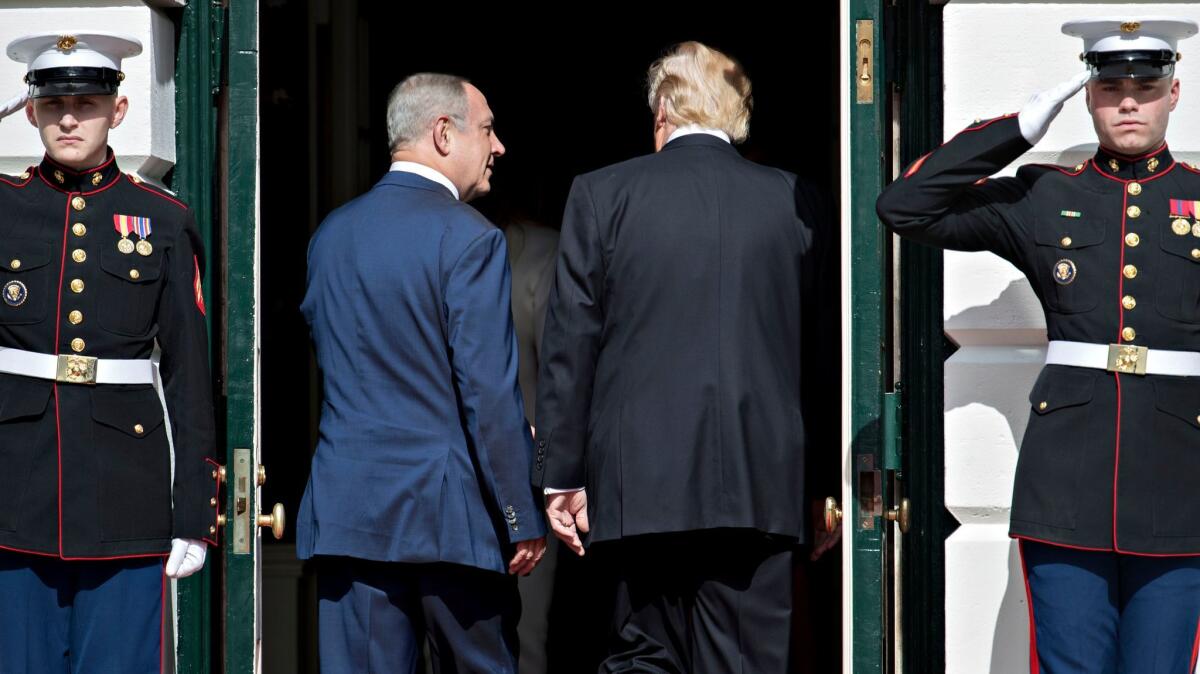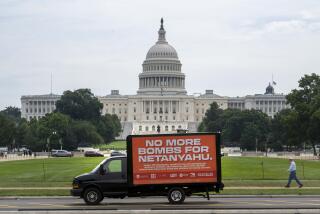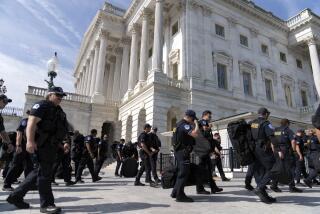Presidential visit to Israel, 43 years after Nixon’s, stirs memories of another era

Reporting from Tel Aviv — As Air Force One approached Ben Gurion International Airport, with a biblical landscape spread out below, the U.S. president aboard likely considered himself imperiled, under siege.
His hosts felt the same way.
For Richard M. Nixon, making the first visit to Israel by a sitting U.S. president, it was less than two months before the slow-grinding wheels of the Watergate scandal would drive him from office, the first president in American history to resign.
In Israel, not even a year had elapsed since a war that had brought the still-young state to the brink of oblivion. It was June 1974, a moment when both Nixon and his Israeli hosts sensed the weight of history, the untold dangers of the future, and the nearly unbearable tensions of the present.
As Nixon did on that journey, President Trump leaves behind a White House gripped by scandal.
On Thursday, the eve of his scheduled departure on his first trip abroad as president, Trump — alluding to the appointment of a special counsel to probe links between his presidential campaign and the Kremlin — tweeted angrily about a “witch hunt” against him.
Like Nixon’s 1974 itinerary, Trump’s trip was to include a visit to Saudi Arabia. But the late president’s six-day travels in the region also took him to Syria — now in the midst of a bloody and ruinous six-year war — along with Egypt and Jordan, now the only Arab states to have peace treaties with Israel.
The Israel of today — hyper-modern, bustling, cosmopolitan — bears little resemblance to the near-garrison state in which Nixon landed. But almost half a century later, many of the same wounds still fester.
Nixon wouldn’t be the only U.S. leader whose sojourn in the Holy Land took place under a political cloud. One of Bill Clinton’s four official visits, in December 1998, came only days before the House of Representatives voted articles of impeachment against him for perjuring himself in connection with the Monica Lewinsky affair.
Clinton’s presidency survived, though his Mideast peacemaking efforts ultimately foundered.
When Nixon landed, Israel was still reeling from the 1973 war, which Israelis call the Yom Kippur war because it broke out as the country was marking the most sacred day on the Jewish calendar. Israeli forces, caught off guard, were nearly overrun by an Arab army before rallying, with crucial supply aid from Washington.
The price was heavy: Israel suffered 2,500 military fatalities, another 7,500 soldiers were wounded, and its people felt they had gazed into an existential abyss. Amid months of wrenching recriminations over Israel’s state of readiness, Israel’s elder stateswoman Golda Meir was forced to step down as prime minister.
“The feeling was of a hangover from the war,” said Abraham Rabinovich, a Jerusalem-based journalist. “People were attending funerals and recovering bodies. There was anger — people asked, ‘How did this happen?’”
Yitzhak Rabin, himself to fall from an assassin’s bullet, was sworn in as prime minister only days before Nixon’s visit. Israel was in economic shambles, forced into austerity by war expenditures and the global energy crisis. U.S. aid accounted for 15% of Israel’s economy.
During Nixon’s 24-hour visit, there was delicate diplomacy afoot. The president and U.S. officials were trying to prod Israel to pull back from parts of the Sinai Peninsula, which it would return to Egypt in 1982.
Though contentious, Nixon’s agenda was perhaps not as herculean a task as Trump has assigned himself. Earlier this month, after a White House meeting with Palestinian Authority President Mahmoud Abbas, Trump mused he might succeed where others had failed.
“It’s something that, I think, is frankly maybe not as difficult as people have thought over the years,” the president said of Mideast peacemaking.
Then, as now, U.S. and Israeli officials had some clashes over presidential-visit protocol.
The Jerusalem Post reported at the time that Nixon did not want to wear a kippa, or Jewish skullcap, during a visit to the Holocaust memorial Yad Vashem. Planning for Trump’s visit also brought arguments over Yad Vashem, including how long to stop there.
While some in Trump’s entourage privately fretted about travel’s toll on a 70-year-old man, the president may need less physical grit to get through the visit than Nixon did. When the late president visited, he was suffering from phlebitis.
“The entire time that Nixon was here he was in agony, and on the verge of going to the hospital,” said Michael Oren, a historian and a former Israeli ambassador to the U.S. “It was a mess.”
Still, Nixon’s landmark visit paid some political dividends, and paved the way for future journeys by other sitting U.S. presidents: Jimmy Carter, Clinton, George W. Bush, Barack Obama, and now Trump.
But the clock was running out on Nixon’s presidency. He left Israel on June 17, 1974. By Aug. 9, disgraced and defeated, he was boarding a military helicopter on the South Lawn of the White House, bound for his long twilight in California.
Special correspondent Mitnick reported from Tel Aviv and staff writer King from Washington.
More to Read
Sign up for Essential California
The most important California stories and recommendations in your inbox every morning.
You may occasionally receive promotional content from the Los Angeles Times.










